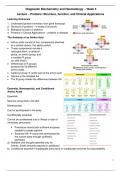College aantekeningen
Lecture notes Diagnostic Biochemistry and Haematology - Proteins Structure, function, and Clinical Applications
- Vak
- Instelling
In this lecture on Diagnostic Biochemistry and Hematology, Week 3 focuses on the intricate world of proteins. Exploring their structure, function, and crucial roles in clinical applications, the session delves into the fundamental anatomy of amino acids, the complex hierarchy of protein structures,...
[Meer zien]





